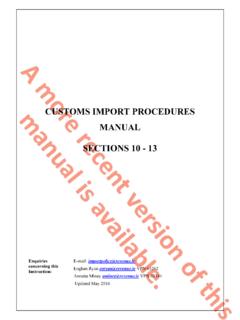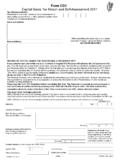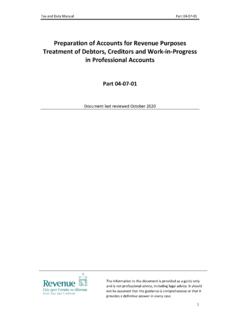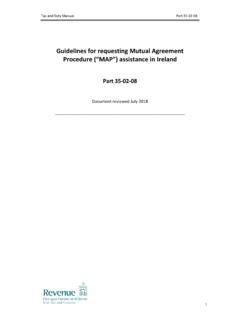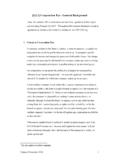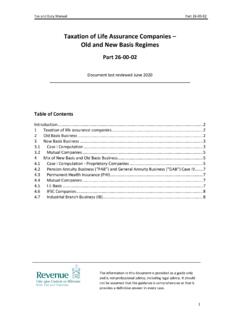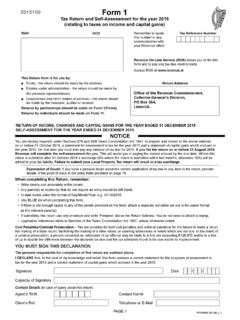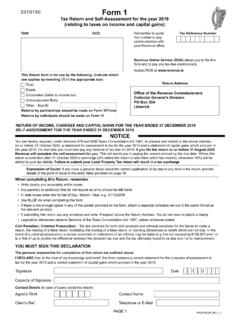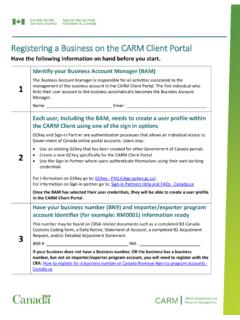Transcription of Customs Manual on Preferential Origin - Revenue
1 Tax and Duty Manual Preferential OriginThe information in this document is provided as a guide only and is not professional advice, including legal advice. It should not be assumed that the guidance is comprehensive or that it provides a definitive answer in every Manual on Preferential OriginDocument last updated December 2021 Queries: Manual provides a guide to the interpretation of the law governing Preferential Origin which is set out in Commission Delegated Regulation (EU) No. 2015/2446 and Commission Implementing Regulation (EU) No. 2015/2447 laying down the detailed rules and implementing provisions of Regulation (EU) No. 952/2013 of the European Parliament and of the Council establishing the Union Customs Code, and the various free trade agreements between the EU and third countries and it should be read in conjunction with these and Duty Manual Preferential Origin2 Table of Preferential Trade Agreements and Rules of Preferential Trade How goods qualify for Preferential Rules of Originating/Non-Originating Wholly obtained Examples of wholly obtained Vessels and factory ships Sufficiently worked or processed Insufficient working or processing Unit of Accessories, spare parts and Neutral Transport/Non-Manipulation Rule/Non-Alteration Principle of Drawback or Bi-lateral Diagonal or Pan Euro-Med Full Supplier s Proof of Procedure for issue of Certificate or (Turkey).
2 Retrospective issue of Movement Certificate Issue of a Duplicate Movement Certificate Issue of Movement Certificate based on proof issued Conditions for making out an Invoice Declaration or Invoice Declaration Approved Exporters - Application Registered Exporters System (REX) - used for GSP, canada , Japan and Validity of Proof of and Duty Manual Preferential Submission of Proof of Importation by Exemptions from Proof of Supporting Documents Acceptable for Proving Originating Preservation of Proof of Origin and Supporting Discrepancies and Formal Amounts expressed in ..443. Verification Methods used to select exports for Procedure used to verify Companies that do not reply to verification Goods that do not qualify for Methods used to select imports for Procedure used to verify Refusal of Preferential treatment without Trade with Customs Union between the EU and Goods not eligible for Preferential Treatment under Customs Evidence required for Preference ( form).
3 Goods not covered by an Procedure for issue of Retrospective issue of Movement Certificate Division of Duration of validity of the certificate where the goods are stored in a free zone, free warehouse or Customs Provisions concerning goods brought by Postal Simplified procedure for the issue of Validity Period of Discrepancies and Formal Agricultural European Coal and Steel Community (ECSC) Accounting Generalised System of Preferences ( ).. Qualifying and Duty Manual Preferential Non - Manipulation Countries and products excluded from Regional Cumulation with the Proof of Origin - REX Statement on Origin and Certificate of Origin Form REX Statement on Origin and Completion of the Form A REX Statement on Origin or Form A issued Form A - Validity of a REX Statement on Origin or Certificate of Origin Form A .. Acceptance of out of date statements or Importation by Issue of Replacement Proof within Registration procedure in the Member States and procedures at export applicable under the REX Treatment of Discrepancies and Formal Exemptions from Proof of Arrangements for administrative Verification of Proofs of ACP Definition of Originating Binding Origin What is BOI?
4 Benefits of BOI for Types of Obtaining Using Validity of Tariff Tariff Goods covered by a Tariff Certificate of Claiming a Tariff Amounts Critical and non-critical Duty to pay at the time of entry if the quota is The EU Commission processes the and Duty Manual Preferential Granting a Block Claiming a Tariff Quota after the closing Goods in a Order Periods for which Tariff Quotas are Units that quotas are measured Tariff Quotas that are not managed on a "first come first serve" Legal instruments that open a Tariff Details specified by a Tariff Quota Legal 1 ..67 APPENDIX 2 ..67 APPENDIX 3 ..68 Tax and Duty Manual Preferential Origin6 IntroductionSince the 1950 s the European Union (EU) has concluded many free trade agreements (FTA s) with European, Mediterranean and other countries. These agreements, known as Preferential trade agreements, permit goods to be traded between the countries party to the agreements at reduced or nil rates of duty.
5 These duties are referred to as Preferential rates of of these agreements includes rules of Origin which must be adhered to for goods to be eligible for Preferential treatment. Products complying with Origin rules are referred to as originating products . Preferential treatment is only permitted in the case of products originating in the EU or the relevant third country with which the EU has an agreement. Originating products are the qualifying goods that are traded under the terms of Preferential exception to this rule is the Customs Union agreement with Turkey, which allows for certain goods classed as in free circulation within the EU or Turkey to be eligible for Preferential treatment. However, most agricultural and all coal and steel products are outside the free circulation rule and must adhere to the Origin rules. The EU has Preferential agreements with the Pan-Euro-Mediterranean countries, including Turkey, Norway, Iceland and Switzerland, the ACP countries (incorporating the African, Caribbean, and Pacific countries), and other countries such as the UK, canada , Japan, South Korea, Singapore, Vietnam, Chile, Mexico, Central America, Colombia, Peru, Moldova, Georgia and Ukraine.
6 The EU also has a Generalised System of Preferences (GSP) with least developed and developing countries. Agreements are in place with the Western Balkan countries known as the Stabilisation and Association Agreements (SAA). These countries include Albania, Bosnia and Herzegovina, the former Yugoslav Republic of Macedonia, Montenegro and Serbia. The EU also has autonomous Preferential arrangements with the overseas countries and territories of the EU and with pan-European cumulation system was created in 1997 based on the European Economic Area (EEA) agreement (1994) between the EC, the European Free Trade Association (EFTA) countries, the Central and Eastern European countries (CEEC) and the Baltic States. The Faroe Islands and the Mediterranean countries have been added and hence we have Pan-Euro-Mediterranean cumulation. This Pan-Euro-Med cumulation is based on a Preferential agreement network, the Origin protocols of which consist of identical rules.
7 The aim of this system is the establishment of free trade between the EU and its Mediterranean partners and amongst the partners themselves. Within the Pan-Euro-Med zone, products that have obtained originating status in any one of the 40 or so countries involved may be added to products originating in any of the others without losing their originating status within the Pan-Euro-Med zone. However, it is important to note that in order to avail of the Pan-Euro-Med cumulation, agreements must be in place not only with the EU but also between the individual countries transitional PEM rules are also in operation since and the new rules are applicable, between the EU and each of the following partners: Albania, Faroe Islands, Georgia, Iceland, Jordan, Norway, Palestine and Switzerland. From the 9th September 2021, the new rules became applicable between the EU and North Macedonia. The process of adoption on rules of Origin with all the other partners is ongoing and at different stages of and Duty Manual Preferential Origin7 For ACP countries the Cotonou Trade Regime expired on 31 December 2007 and since that date some ACP countries have made new agreements with the EU.
8 Those ACP countries that do not have new agreements must avail of EU has in place a Generalised System of Preferences (GSP) for Developing and Least Developed Countries. The GSP system is intended, through the elimination of, or reductions in, Customs duties, to stimulate reciprocal trade in goods as well as access to the EU market for products of developing Manufacture means any kind of working or processing including assembly or specific operations. Material means any ingredient, raw material, component or part, etc., used in the manufacture of the product. Product means the product being manufactured, even if it is intended for later use in another manufacturing operation. Goods mean both materials and products. Ex-Works Price means the price paid for the product ex works to the manufacturer in the EU or relevant third country in whose undertaking the last working or processing is carried out, provided the price includes the value of all the materials used, minus any internal taxes which are, or may be, repaid when the product obtained is exported.
9 Value of materials means the Customs value at the time of importation of the non-originating materials used, or, if this is not known and cannot be ascertained, the first ascertainable price paid for the materials. Added value means the ex-works price minus the Customs value of each of the products incorporated which did not originate in the country in which those products were obtained. Consignment means products which are either sent simultaneously from one exporter to one consignee or covered by a single transport document covering their shipment from the exporter to the consignee or, in the absence of such a document, by a single invoice. Territories include territorial waters. Most Favoured Nation (MFN) rule stipulates that a country must treat all countries equally meaning that it must apply the same tariff rate to all countries with which it does not have a Free Trade Agreement. The EU MFN rate is the rate that applies to third countries with which the EU does not have a trade agreement.
10 This in most cases is the maximum tariff rate agreed with the and Duty Manual Preferential Trade Agreements and Rules of Trade AgreementsThe EU has concluded trade agreements with certain non - EU countries which allow exports from the EU to enter the markets of these countries at a reduced or nil rate of duty. They also permit imports of goods into the EU at a reduced or nil rate of duty. These agreements are known as Preferential Trade Agreements and the duties involved are referred to as Preferential rates of most recent of these was the Trade and Cooperation Agreement (TCA) agreed between the EU and UK which has effect since the 1st January 2021. It provides for zero tariffs and zero quotas on all trade between the EU and UK in goods that comply with the appropriate rules of Origin in the TCA. In order to qualify for tariff free terms, goods must be able to satisfy the agreement s rules of Origin criteria.


